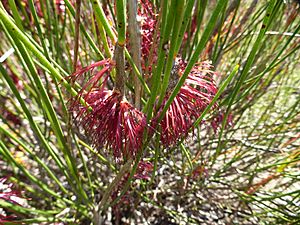Calothamnus longissimus facts for kids
Quick facts for kids Calothamnus longissimus |
|
|---|---|
 |
|
| Calothamnus longissimus growing in Manea Park, Bunbury. | |
| Scientific classification | |
| Genus: |
Calothamnus
|
| Species: |
longissimus
|
| Synonyms | |
|
Melaleuca longissima Craven & R.D.Edwards |
|
Calothamnus longissimus is a special plant found only in the south-west of Western Australia. It belongs to the myrtle family, called Myrtaceae. This plant is a small, spreading shrub. It has very long, thin leaves and grows pretty red flowers in spring.
Contents
What Does Calothamnus longissimus Look Like?
Calothamnus longissimus is a shrub that can grow up to about 1.5 meters (5 feet) tall. It has many branches and a special kind of bark that feels like cork. Its leaves are thin but stiff. They are usually round when you look at them from the side. These leaves are very long, about 150 to 300 millimeters (6 to 12 inches) long, and they often curve.
The flowers are a deep red color. They grow in small groups, almost hidden in the corky bark of the plant. Inside the flowers, there are parts called stamens. These stamens are grouped into four claw-like bundles. Some of these bundles are longer and wider than others. The plant flowers from August to October. After the flowers, it grows woody fruits called capsules. These capsules are also almost hidden in the corky bark.
How Calothamnus longissimus Got Its Name
The plant Calothamnus longissimus was first officially described in 1862. This was done by a botanist named Ferdinand von Mueller. He worked for the government of Victoria. The second part of its scientific name, longissimus, comes from a Latin word. It means "longest," which makes sense because of its very long leaves!
Where Does Calothamnus longissimus Live?
You can find Calothamnus longissimus in certain areas of Western Australia. These areas are called the Avon Wheatbelt, Geraldton Sandplains, and Swan Coastal Plain. It likes to grow in a type of shrubland called kwongan.
Is Calothamnus longissimus Safe?
The government department in Western Australia that looks after parks and wildlife says that Calothamnus longissimus is "not threatened." This means there are enough of these plants, and they are not in danger of disappearing.
Images for kids



